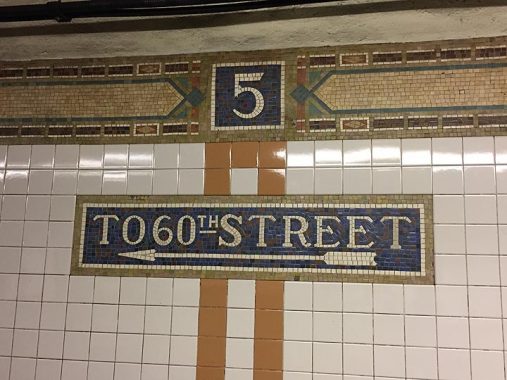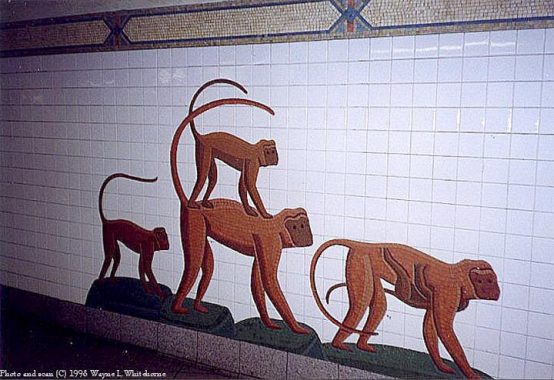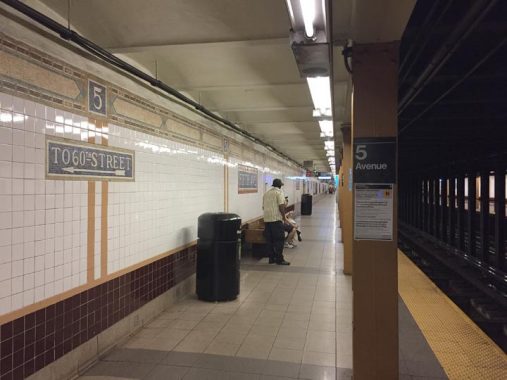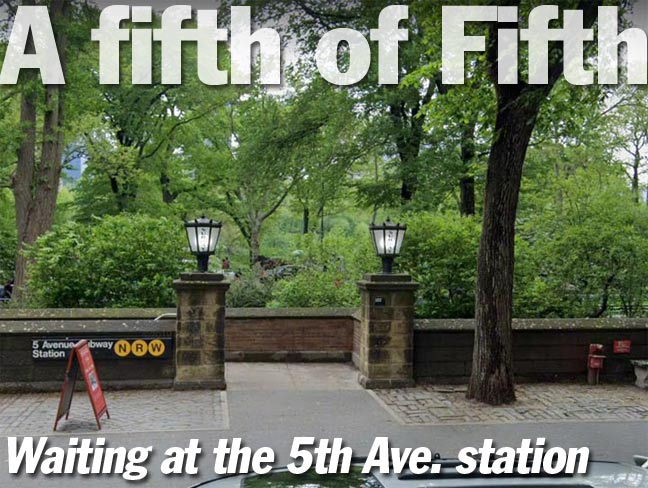There are three 5th avenue stations in the NYC subways, each of them on crosstown lines. 5th Avenue, the spine of Manhattan Island, serves as the divider between East and West Streets and from its inception in the early decades of the 19th Century, has always been somewhat set apart. At first 5th Avenue was the home of the mansions of the wealthy and famous, but after St. Patrick’s Cathedral was constructed at 50th Street between the 1850s and 1880s, high-end retail followed as well as other high-concept churches, but of the Protestant and Jewish faiths (5th Avenue was the home of Temple Emanu-El from the 1870s to the 1920s.) Of course, 5th Avenue has also been the east end boundary of Central Park since the 1860s.
Thus, 5th Avenue has never had to shoulder the burden of an elevated train or a subway, the only north-south Manhattan avenue to make that boast: even 10th and 11th Avenues supported freight railways long ago. However, there have been crosstown els and subways that stop under 5th Avenue, and today three subway lines have 5th Avenue stops, the #7 Flushing Line, the IND E and m trains, and the BMT Broadway line as it turns east beneath Central Park toward Queens. The IRt and BMT stations were built in the mid-1910s when the subways were at their tile-and-mosaic apotheosis.

I recently stopped in that BMT 5th Avenue station to catch a train to Queens. Since we’re in Manhattan, mosaic signs appear on staircases that go to eastbound (Queens) or southbound (Brooklyn) stations.

The BMT features side platforms and thus, is the only 5th Avenue station to feature a station ID mosaic plaque. This one is mostly blue with white lettering, surrounded by a “frame” of light brown.

Most BMT stations feature mosaic friezes near the roofline. 5th Avenue station has one that includes the blue, white and brown numeral 5 at intervals. The subway line travels under 60th Street between 5th Avenue and the East River.

In 1997, the 5th Avenue station acquired playful animal mosaics by Ann Schaumburger called “Urban Oasis.” No doubt, the nearness of the central Park Zoo inspired the artwork. Animal mosaics can also be found in the 81st Street station on the B/C IND station as the Museum of Natural History is nearby.

The 5th Avenue station is a no-nonsense, relatively feaureless station except for the busy mosaics.

However, the city designed interesting stone-columned entrances to subway stations on 5th Avenue serving the BMT and on the other side of Central Park which allow entrance to the Columbus Circle station hosting the A,B,C,D and #1 trains. They feature large post-top lamps that have thankfully been allowed to survive.
Check out the ForgottenBook, take a look at the gift shop, and as always, “comment…as you see fit.”
7/26/19


7 comments
Madison Avenue, like Fifth, has always been free or any subways, elevateds, or railroads for its entire length from 23rd to 135th Streets. However, it did have streetcars until 1935, when buses took over (the first major streetcar-to-bus conversion in Manhattan). Fifth Avenue, on the other hand, never had streetcars, so it’s the only major N-S Manhattan avenue that has never supported any rail-based transportation for its entire length. It did have horse-drawn coaches beginning in 1885, which in 1907 became the first major urban motor bus service in the United States. The firm that operated the buses, Fifth Avenue Coach Company, grew to control 90% of Manhattan’s bus routes and all Bronx bus routes. In 1962 the firm suddenly went out of business after a new management team provoked its work force into a strike. NYC took over the routes immediately, which ever since are part of NYC Transit’s route network. Source: my 2015 book From a Nickel to a Token, Chapter 16.
One other unrelated point – Temple Emanu-El has been on Fifth Avenue since 1868, when it moved from Lower Manhattan to a then-new building at 43rd Street. As midtown morphed into a commercial area, in 1929 Temple Emanu-El relocated to its present building at 65th Street and Fifth Avenue. Source: Temple Emanu-El website http://www.emanuelnyc.org/about-us/our-history.
It seems that the tracks really run somewhat diagonally as opposed to along 60th street once they get near the station.. One entrance is at the corner of 5th and 60th, while the other is on Central Park South, about a block south. It’s probably beginning the big turn south for the 57th st. station.
North of the 57th St. Station, the BMT tunnel turns under Central Park South (59th St.) and runs east to a point about 200 feet west of Fifth Avenue. The Fifth Ave. station is on a diagonal with the west end at 59th Street and Grand Army Plaza, and the east (operationally north) end at 60th St. and 5th Ave. East of 59th Street the tracks continue under 60th Street, which is why the tracks jog at both ends of the Fifth Ave. station.
For decades, the Fifth Avenue station mosaics, like most of the BMT stations in Manhattan, were covered over by the monochrome monstrosities that the MTA put up in the 1970’s. Thankfully these have been removed and the original mosaics have been repaired and are now visible for all to enjoy.
Saw my first “Iron Maiden” in this station.
Circa 1960.
Goin back to Elmhurst after a cold day of sledding in Central Park.
.
Iron Maiden? EXCELLENT! (Air guitars twang)
there is an old spur for the subway to make a turn south here, but i don’t think mta has any plans to use that.